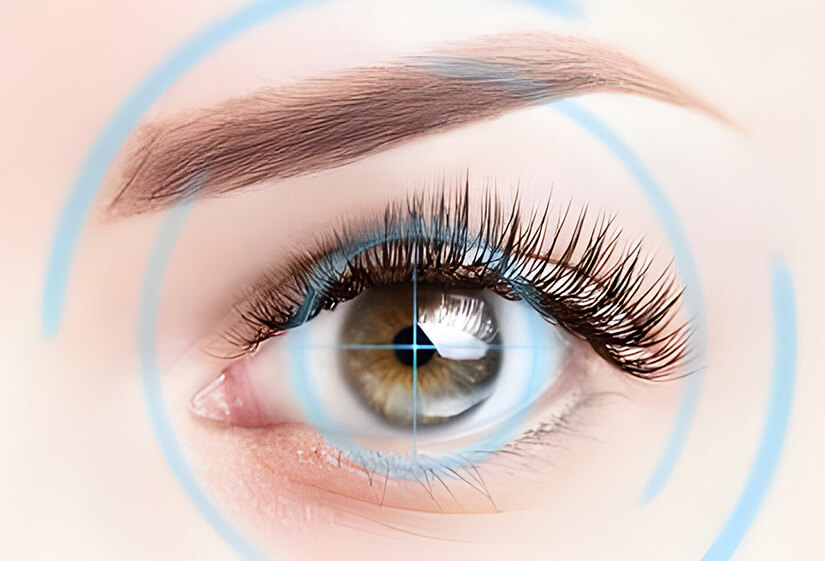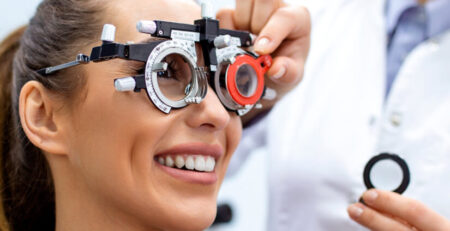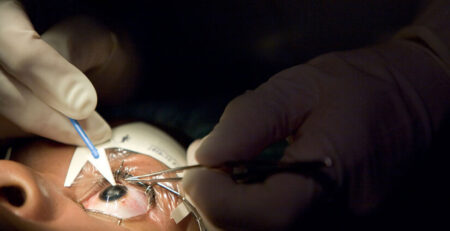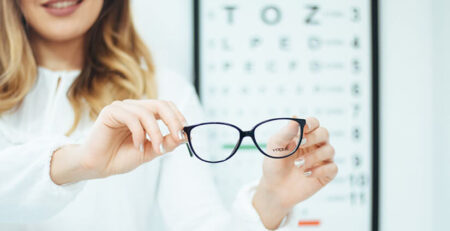Refractive Errors: Types, Signs, Causes, and Treatment
Do you get headaches from reading a book or have difficulties reading road signs? If yes, you may be experiencing some kind of vision impairment due to a refractive error. A refractive error is an extremely common eye condition that makes your vision blurry.
There are four major types of refractive errors. Some make it hard to focus your eyes on nearer objects, like reading a book or scrolling through a phone. Others may make faraway objects look blurry, like traffic signs or television. In this blog, we’ll discuss the different types of refractive errors, their types, signs, why they’re bothering you, and refractive error treatments as well.
What are Refractive Errors?
Refractive errors are eye disorders that affect your eye’s ability to refract or bend the light that enters your retina. This makes it difficult for your eyes to focus on what it is seeing. It depends upon the type of refractive error that you struggle with all the time or only in specific situations. The severity of the error determines how much your vision will be affected.
Mild refractive errors may hardly cause any difficulty to your sight, while severe ones may leave you with unforeseen circumstances. So, it’s crucial to get treated with time.
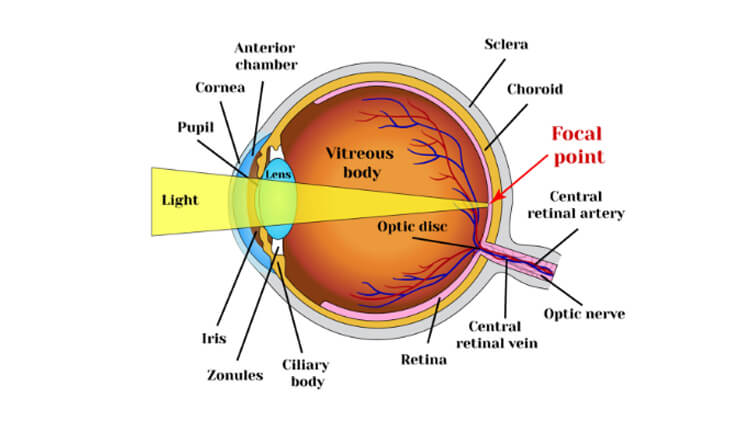
Different Types of Refractive Errors
There are four most common refractive error types that you may be suffering from without knowing. Most people with these errors develop them over time as they age, but you can develop them at any point in your life, even if you have had clear vision before. So, it’s important to understand these errors so you can get your eyes examined accordingly.
1. Nearsightedness (myopia)
Do you have difficulty reading traffic signs from a distance or can’t see what’s written on the board from far away? The reason: Myopia. People who have this type of refractive error have difficulty seeing objects located far away but can see closer objects. Usually, this happens because your eye grows too long from front to back. This generally develops in kids when they’re entering their teenage years.
2. Farsightedness (hyperopia)
If you have problems seeing closer objects, you may have developed hyperopia. It’s the opposite of myopia. People who have this refractive error type might be able to read words on a screen on the other side of the room but struggle with reading notes that are in front of them. People with this problem are usually born with it.
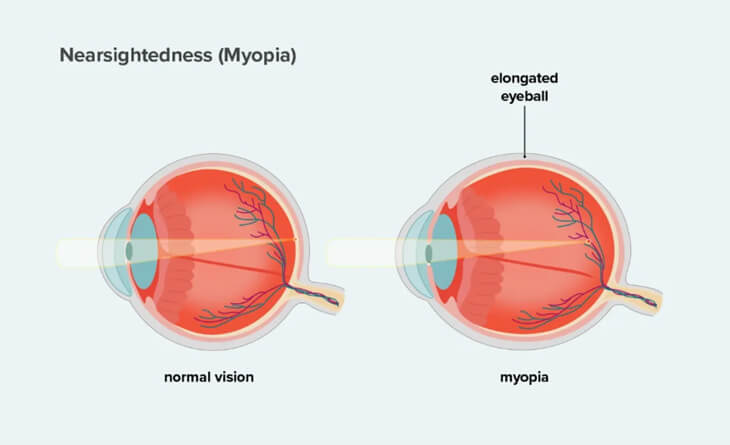
3. Presbyopia (age-related farsightedness)
You may have seen elderly people holding newspapers away from their eyes to read them, a clear sign of Presbyopia. Presbyopia is a particular type of farsightedness that develops as you age. It makes it harder for you to see things up close, which is why people need reading glasses as they age. Presbyopia develops when your eye lens becomes less flexible and usually develops in people older than 40.
4. Astigmatism
In this refractive error, the distance at which objects look blurry is not specified. It depends on your eye shape, age, and error level. Usually, people suffering from this problem have oval shaped cornea, so that one axis is more curved than the other. This makes light entering your eyes bend and distort more in one plane as compared with other. It can develop at any stage of life, and some people are born with it.
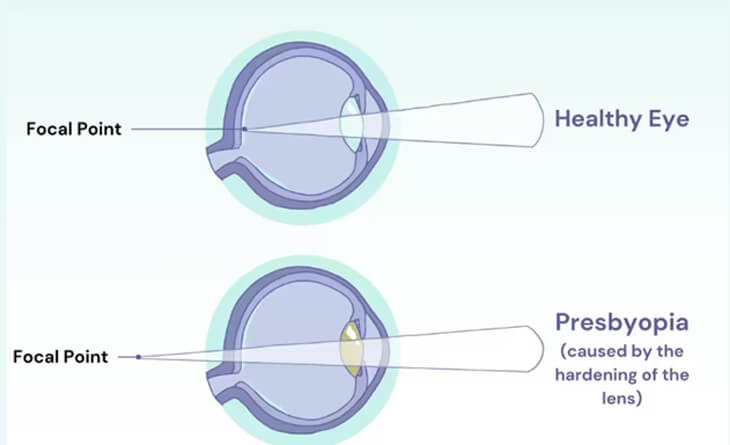
Signs of Refractive Errors
After understanding the different refractive error types, it’s crucial to understand their signs. So, in this section, we’ll discuss their signs and symptoms so that you can analyze which problem you’re dealing with.
The most common symptom of these errors is blurred vision. Other signs include:
- Hazy Vision
- Double Vision
- Glares around lights
- Headaches or migraines
- Eye strain(soreness or fatigue in your eyes)
- Difficulty in focusing (especially while reading or looking at a screen)
If you’re experiencing any of these symptoms, you must look for refractive eye treatments.
What causes Refractive Errors?
You might be wondering, even though you were able to see clearly at a younger age, what caused these errors? Well, there are different causes for different refractive errors. They can be caused by a number of things, like aging, changes in the shape of your cornea, or the length of your eyeball being too long or short.
Let’s look at the causes of each error so you can avoid these in the meantime.
1. Causes of Hyperopia
What causes people to be unable to see near objects? Eyeball size is the most commonly seen cause of this error. This occurs when the eyeball is shorter than normal, causing light rays to focus behind the retina instead of directly on it. Family history also plays a significant role in this error’s development. Uncorrected hyperopia may cause squints and headaches.
2- Causes of Myopia
Myopia tends to run in families, suggesting that if your parents and grandparents have it, chances are you’re also going to suffer from it. The cause of this error is when the eyeball is too long, causing light rays to focus in front of the retina. This also often develops during adolescence as your eye continues to grow and change. Also, children associated with more near work, like reading and computer use, have a higher risk of this refractive error. Refractive error treatments for this are mostly getting new spectacles or contact lenses.
3. Causes of Presbyopia
Usually, it is primarily a result of age-related changes in your eye and loss of flexibility in the lens. As you age, eye lenses become less elastic and lose their ability to change shape and adjust to the vision. This is a physiological change that is bound to occur with everyone.
4. Causes of Astigmatism
It occurs when the cornea of the eye is irregularly shaped, leading to blurred or distorted vision irrespective of the object’s distance. This refractive error type also runs in families, suggesting that if one or both parents have it, their children are more likely to develop it as well. Also, if your child excessively rubs his/her eyes, it sometimes leads to changes in the cornea’s shape, leading to astigmatism.
How can these errors be treated?
Below, we have mentioned different refractive error treatments:
1. Hyperopia (Farsightedness)
- Eyeglasses: Eye specialists prescribe lenses with a convex shape that bends light rays into the eye, helping the affected person focus properly.
- Contact Lenses: This error can also be corrected using soft contact lenses.
- Refractive Surgery: Various surgeries like LASIK are used to reshape the cornea to correct this refractive error. ICL is alo a good option once you have reached adulthood.
2. Myopia (Nearsightedness)
- Eyeglasses: Prescription lenses with a concave shape to divert light rays help the affected person have a clearer vision.
- Contact Lenses: Just like hyperopia is corrected using a lens, this error can be corrected using the correct contact lens.
- Orthokeratology: This refractive eye treatment involves wearing special rigid contact lenses overnight to temporarily reshape the cornea. The effect lasts throughout the day without the need for glasses.
- Refractive surgery: Refractive surgeries like LASIK, SMILE and ICL are good options to treat myopia once your power has stabilised.
3. Presbyopia
- Reading Glasses: This approach requires two glasses for distance and near vision.
- Bifocal or Progressive Addition Lenses: You can get a bifocal lens rather than getting different glasses for different tasks. These eyeglasses have two or more prescriptions to correct both vision.
- Multifocal Contact Lenses: Soft contact lenses with multiple focal zones are used in this method.
4. Astigmatism
- Prescription eyeglasses: This is the most common way to correct this error; special lenses called toric lenses are prescribed for this.
- Contact Lenses: Contact lenses like toric lenses are designed specifically for this refractive error type and help correct this error.
- Refractive Surgery: If you are seeking a more permanent solution, surgeries like LASIK and PRK are your solution. However, not everyone with this error is eligible for surgery; a thorough evaluation by an eye care professional is necessary.
How can I reduce my risk of developing these errors?
Precaution is better than cure. Keeping this proverb in mind, we have provided a few precautionary measures that will help you reduce the risk of developing refractive errors. These measures mostly include adopting a healthy lifestyle, such as eating a healthy diet.
1. Scheduling regular eye check-ups
Why not diagnose the disease before it becomes a problem? So, it is advised that routine eye exams be scheduled with the best eye specialist in India. Even if you don’t have any vision problems, early detection of these errors is essential for maintaining good sight.
2. Eating a healthy diet
Eating a balanced diet of fruits, vegetables, and omega-3 fatty acids is important for clear vision and avoiding other diseases. Foods like leafy greens, fish, nuts, and fruits contain nutrients that support overall eye health.
3. Wearing prescription glasses
You should wear appropriate eye glasses to safeguard your eyes from unnecessary strain. Straining of eyes when not wearing glasses, contributes to further increase in power.
4- Take Breaks
Follow the 20-20-20 rule when using digital devices. This means every 20 minutes, take a 20-second break and look at something 20 feet away to reduce eye strain. This is a very effective refractive eye treatment.
5. Limit your Screen Time
Excess of everything is bad, and excessive screen time is a major concern. So, minimize the long screen time and take regular breaks to rest, blink your eyes frequently, and adjust your screen’s brightness and contrast to reduce eye strain.
6. Avoid excessive weight gain
Obesity serves as a cause of many diseases like diabetes, and this, in turn, may cause an increased risk of developing certain eye conditions. This can contribute to different refractive error types.
7. Quit Smoking
Smoking is linked to various eye conditions like cataracts. This can affect your vision and increase the risk of developing refractive errors.
8. Manage other diseases
Chronic health conditions like diabetes, hypertension, and other cardiovascular diseases can affect eye health and increase the risk of developing refractive errors.
9. Limit Alcohol Consumption
Excessive alcohol consumption can lead to dehydration, i.e., a lack of water in your body, and that can affect your eye health. Limit alcohol intake and stay hydrated to support eye health.
10- Outdoor activity
Regular outdoor activity 60-90 min a day, especially in children can prevent myopia from progressing.
Summing up
In conclusion, refractive errors are a common vision problem that most of our population suffers from. Irrespective of the patient’s age, these are prevalent in everyone. With the help of this blog, you must have understood the different types of refractive errors that people generally suffer from. Whether it’s through corrective lenses, refractive surgery, or lifestyle adjustments, various refractive eye treatments are available to address these issues.
However, early detection through regular eye exams remains an important factor in managing these conditions effectively. By prioritizing eye health and seeking professional guidance when needed, you can reduce the effect of these errors on your daily lives.
You can take the first step to better vision today by scheduling an eye exam with the best eye specialist in India, discussing your vision needs, and exploring personalized treatment options. Your eyesight deserves the best care possible!

